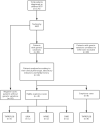Screening for Genetic Mutations for the Early Diagnosis of Common Variable Immunodeficiency in Children With Refractory Immune Thrombocytopenia: A Retrospective Data Analysis From a Tertiary Children's Center
- PMID: 33425813
- PMCID: PMC7793988
- DOI: 10.3389/fped.2020.595135
Screening for Genetic Mutations for the Early Diagnosis of Common Variable Immunodeficiency in Children With Refractory Immune Thrombocytopenia: A Retrospective Data Analysis From a Tertiary Children's Center
Abstract
Aim: This study aimed to identify common variable immunodeficiency (CVID) by high-throughput next-generation sequencing (NGS) in children with refractory immune thrombocytopenia (RITP) to facilitate early diagnosis. Methods: CVID-related genetic mutations were explored in patients with RITP during 2016-2019. They were tested consecutively through NGS by the ITP team of the tertiary children hospital in China. An evaluation system was devised based on the phenotype, genetic rule, and serum immunoglobulins (Igs) of all patients with RITP. The patients were divided into highly suspicious, suspicious, and negative groups using the evaluation system. Results: Among 176 patients with RITP, 16 (9.1%) harbored CVID-related genetic mutations: 8 (4.5%) were highly suspicious of CVIDs. Five had mutations in tumor necrosis factor receptor superfamily 13B (TNFRSF13B), one in lipopolysaccharide responsive beige-like anchor protein (LRBA), one in nuclear factor kappa-B2 (NF-κB2), and one in caspase recruitment domain11 (CARD11). Others were classified into the suspicious group because the clinical phenotype and pedigree were suggestive, yet insufficient, for diagnosis. Repeated infection existed in all patients. Two had an allergic disease. Positive autoimmune serologies were noted in 62.5%. Five had a definite positive family history. The median serum immunoglobulin (Ig)A, IgG, and IgM levels were 0.3875, 6.14, and 0.522 g/L, respectively. Nearly 85.7% of patients had insufficient serum IgA levels, while 37.5% had low IgG and IgM levels. Conclusions: High-throughput NGS and a thorough review of the medical history are beneficial for the early diagnosis of patients without any significant clinical characteristics, distinguishing them from those with primary pediatric ITP. The cases suspicious of CVID need further investigation and follow-up to avoid deterioration.
Keywords: children; common variable immunodeficiency; mutation; next-generation sequencing; refractory immune thrombocytopenia.
Copyright © 2020 Ma, Fu, Gu, Chen, Zhang, Zhao, Zhu, Liu and Wu.
Conflict of interest statement
The authors declare that the research was conducted in the absence of any commercial or financial relationships that could be construed as a potential conflict of interest.
Figures
Similar articles
-
Chronic Refractory Immune Thrombocytopenia Is Associated With Variants in Immune Genes.Clin Appl Thromb Hemost. 2021 Jan-Dec;27:10760296211059813. doi: 10.1177/10760296211059813. Clin Appl Thromb Hemost. 2021. PMID: 34786962 Free PMC article.
-
Mutation in IRF2BP2 is responsible for a familial form of common variable immunodeficiency disorder.J Allergy Clin Immunol. 2016 Aug;138(2):544-550.e4. doi: 10.1016/j.jaci.2016.01.018. Epub 2016 Mar 23. J Allergy Clin Immunol. 2016. PMID: 27016798 Free PMC article.
-
Rare TACI Mutation in a 3-Year-Old Boy With CVID Phenotype.Front Pediatr. 2019 Oct 15;7:418. doi: 10.3389/fped.2019.00418. eCollection 2019. Front Pediatr. 2019. PMID: 31681716 Free PMC article.
-
Disorders of CTLA-4 expression, how they lead to CVID and dysregulated immune responses.Curr Opin Allergy Clin Immunol. 2019 Dec;19(6):578-585. doi: 10.1097/ACI.0000000000000590. Curr Opin Allergy Clin Immunol. 2019. PMID: 31573993 Review.
-
Pathogenesis of immune thrombocytopenia in common variable immunodeficiency.Autoimmun Rev. 2020 Sep;19(9):102616. doi: 10.1016/j.autrev.2020.102616. Epub 2020 Jul 17. Autoimmun Rev. 2020. PMID: 32682985 Review.
Cited by
-
Increased proportion of Th17/Treg cells at the new diagnosed stage of chronic immune thrombocytopenia in pediatrics: the pilot study from a multi-center.Eur J Pediatr. 2021 Nov;180(11):3411-3417. doi: 10.1007/s00431-021-04121-z. Epub 2021 May 27. Eur J Pediatr. 2021. PMID: 34046719
-
Autoimmune Cytopenias in Common Variable Immunodeficiency Are a Diagnostic and Therapeutic Conundrum: An Update.Front Immunol. 2022 Jun 20;13:869466. doi: 10.3389/fimmu.2022.869466. eCollection 2022. Front Immunol. 2022. PMID: 35795667 Free PMC article. Review.
-
Autoantibodies in immunodeficiency syndromes: The Janus faces of immune dysregulation.Blood Rev. 2022 Sep;55:100948. doi: 10.1016/j.blre.2022.100948. Epub 2022 Mar 18. Blood Rev. 2022. PMID: 35428517 Free PMC article. Review.
-
Chronic Refractory Immune Thrombocytopenia Is Associated With Variants in Immune Genes.Clin Appl Thromb Hemost. 2021 Jan-Dec;27:10760296211059813. doi: 10.1177/10760296211059813. Clin Appl Thromb Hemost. 2021. PMID: 34786962 Free PMC article.
-
[Splenectomy for the treatment of common variable immunodeficiency complicated with cytopenia: report of one case and literature review].Zhonghua Xue Ye Xue Za Zhi. 2021 Oct 14;42(10):846-850. doi: 10.3760/cma.j.issn.0253-2727.2021.10.009. Zhonghua Xue Ye Xue Za Zhi. 2021. PMID: 34788925 Free PMC article. Review. Chinese.
References
-
- Salzer U, Bacchelli C, Buckridge S, Pan-Hammarström Q, Jennings S, Lougaris V, et al. . Relevance of biallelic versus monoallelic TNFRSF13B mutations in distinguishing disease-causing from risk-increasing TNFRSF13B variants in antibody deficiency syndromes. Blood. (2009) 113:1967–76. 10.1182/blood-2008-02-141937 - DOI - PMC - PubMed
LinkOut - more resources
Full Text Sources
Miscellaneous


